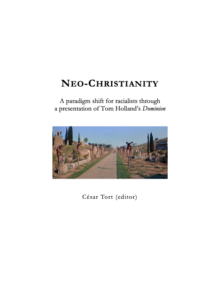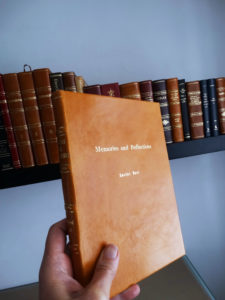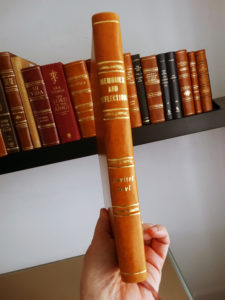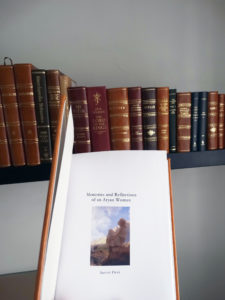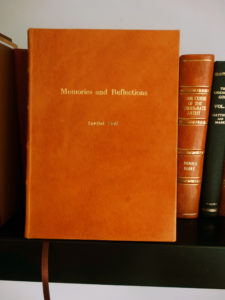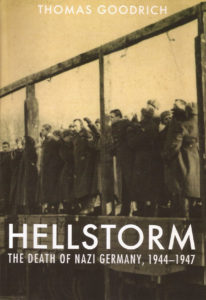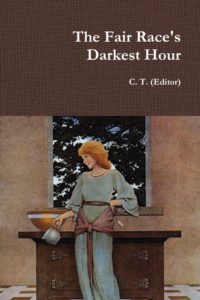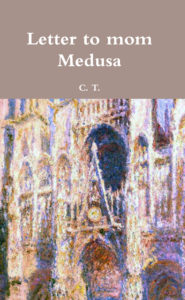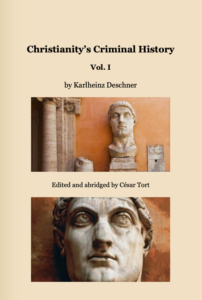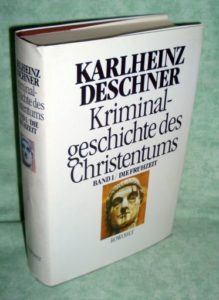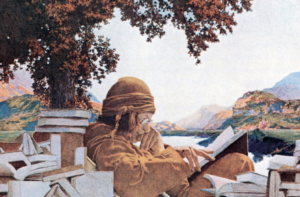The book can now be read/printed here. The content is so important that I will modify the featured post.
Category: Daybreak Publishing
Next book
As can be seen in the table of contents below, the previous entry is the penultimate article in our forthcoming book-PDF Neo-Christianity:
Contents
By way of preface
Unhistorical Jesus – [A review of Richard Carrier’s book]
The New Testament was authored by rabbis – David Skrbina
How Christianity became Neo-Christianity – Tom Holland *
Hitler’s anti-Christianity – Richard Weikart *
The Appian Way – Editor
Law against Christianity – Friedrich Nietzsche
Since I am currently revising the annotated articles, I will not be posting many entries while I work on it.
____________
(*) These texts are annotated by the Editor.
Cute books…
These days I have sent the first copies of Savitri Devi’s book to two buyers.
Unfortunately, as these leather bindings are made by a professional bookbinder, they are costing me a lot of money together with the shipping either to the USA or to the UK.
As soon as I have the financial means to get a workshop to bind them myself, it will be a pleasure to print & bind the Savitri copies and other books in ‘Our Books’ except for Hellstorm and Letter to mom Medusa, which are already available without traditional binding.
…the PDF of Savitri Devi’s book is ready and can be accessed here.
An Englishman who has been generous with his donations told me something very true. Such books shouldn’t be read on screen! It is almost a desecration. And in our cancellation culture, I agree with an editor’s advice to me: find a local printer to avoid future cancellations. (After Lulu, Inc., cancelled me, I would be cancelled again if I ever dare to use another print-on-demand service of any company, as they are all notorious for cancelling dissenters’ accounts.)
The editor’s advice is sound. But since I don’t have the funds to print, say, twenty copies of most of ‘Our books’, I have no choice but to bind them myself. A book like Memories and Reflections of an Aryan Woman (original in French: Souvenirs et Réflexions d’une Aryenne) deserves a truly artistic binding, like this one:
For the same reason, I have asked a traditional bookbinder to give me lessons. Except for the machine to make the gilt lettering of the title on the front cover, the binding equipment is not so expensive. Although I have not yet taken my first class, I will be taking them as visitors to this site start asking me for traditionally bound books of Memories and Reflections of an Aryan Woman or any other of our ‘Daybreak Press’ books. He who will be teaching me will be binding them while I learn the craft and buy, bit by bit, the binding apparatus.
For the moment the books will not be as artistic as the one in the embedded video above. I will only be able to do that when my binding technique has matured. But they will look like these that I already have in my home library.
If anyone has a better idea to solve the dilemma that literary gems like Savitri’s book deserve a beautifully printed edition (instead of a bare PDF saved on our hard drives that very few will read), let me know in the comments section.
Those wishing to order a traditionally-bound copy of any of our books, including Savitri’s, please contact me by email (that appears in the middle of this comment).
Our books
You can donate to this site via PayPal or crypto-currencies here.
If you want to unplug from the Matrix that controls you, it is an absolute categorical imperative that you read the first book on our list: Hellstorm: The Death of Nazi Germany, 1944-1947 by Thomas Goodrich (or at least J.A. Sexton’s book review). Hellstorm exposes the modern world’s best-kept secret: the Holocaust committed by the Allies, from 1945 to 1947, against defenceless Germans.
For the best-kept secret of the ancient world, how Christians destroyed Greco-Roman culture, see the essay ‘Rome against Judea; Judea against Rome’ (pages 33-123 of The Fair Race’s Darkest Hour). This long essay is so important to understand our point of view that it is also available in French. An abridged version of the original article by this Spanish author may be read here. Articles from this site in the same vein that have been translated into German can be read here.
Hellstorm and The Fair Race are only the first stepping stones for the adventurer who has already dipped his feet in the psychological Rubicon. Now, thanks to the third stepping stone, Savitri Devi’s Memories and Reflections of an Aryan Woman, he can finish crossing the river. (When we get the proper sponsorship, hard copies of our books will be available as traditional binding. See this post from February 2023 for details.)
 White nationalists have misdiagnosed the causes of Aryan decline. The Jewish problem is merely a catalyst for an ethno-suicidal process that had been brewing since Constantine handed over the empire to his bishops. This abridged translation of Christianity’s Criminal History: Volume I by German author Karlheinz Deschner is the first step to understanding this issue.
White nationalists have misdiagnosed the causes of Aryan decline. The Jewish problem is merely a catalyst for an ethno-suicidal process that had been brewing since Constantine handed over the empire to his bishops. This abridged translation of Christianity’s Criminal History: Volume I by German author Karlheinz Deschner is the first step to understanding this issue.
If someone wishes to give a book critical of the American racial right to a friend—albeit critical from the point of view of National Socialism—Daybreak is your book!
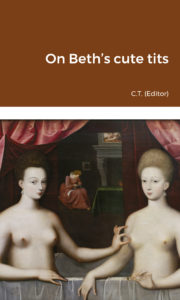
Unless patriarchy is restored in the West, feminism will eventually destroy the white race, as explained in On Beth’s Cute Tits. For those who only want to read a single article from this anthology we recommend ‘Our lycanthropic lust’ (pages 99-116).
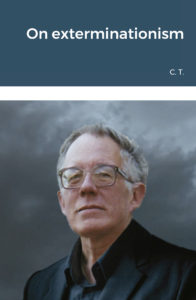 Few racialists, such as Savitri Devi, and William Pierce at the end of their best-known books, have dared to touch on truly eschatological issues as our ultimate goal. On exterminationism collects thirty articles (and an appendix containing some prophetic texts of the Indo-Aryans that give context to this ultimate goal).
Few racialists, such as Savitri Devi, and William Pierce at the end of their best-known books, have dared to touch on truly eschatological issues as our ultimate goal. On exterminationism collects thirty articles (and an appendix containing some prophetic texts of the Indo-Aryans that give context to this ultimate goal).
Letter to Mama Medusa is the first book of my magnum opus From Jesus to Hitler (see the comments section of this post). Unlike the others, this one won’t be available as a PDF. However, it is already available in printed form here.
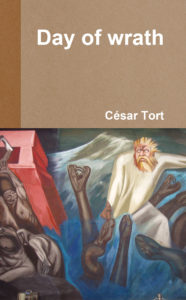
While Letter to mom Medusa strikes an emotional chord, the translated chapters in Day of Wrath of the same work are more intellectual. Anyone who wants to know the story of how abusive parents have been driving their children mad since time immemorial, should read this book.
After much work, the PDF of the revised first volume of our translation of Karlheinz Deschner’s Kriminal-geschichte des Christentums (Krimi they call this work in Germany), Christianity’s Criminal History: Volume I, is finally ready.
Compared to the foreword I published last month, I added several paragraphs to that foreword (grey letters mean that those sentences also appeared in the previous foreword):
One thing I have noticed about virtually all dissident right-wing intellectuals and commentators, including the racialists, is that they do not try to reinvent the history of the white race as William Pierce did in Who We Are. They do the opposite: they rely on Christian or secular authors ignorant of the real history of the West. So-called dissidents do not seem to realise that, to understand their darkest hour, it is necessary to make a clean sweep of everything that is taught in universities about the humanities and to start rewriting history from scratch.
That is why I chose the weirwood tree as the symbol of my website. It reflects that what we should focus on is the historical past of the white race, the true past (read The Fair Race’s Darkest Hour listed on page 3), not on what is said even in the (semi-normie) forums of the racial right. Whoever is able to touch the millenary tree and see the past not as we are told it happened, but as it actually happened—especially the history of Christianity!—changes his worldview all at once. In his after-dinner conversations, Hitler, who had touched the sacred tree, said: ‘Christianity is the greatest regression humanity has ever experienced.’ Alas, as the Romanian philosopher Emil Cioran, who once described himself as a Hitlerist, wrote, ‘The whole world has forgiven Christianity.’
Well, not the whole world… As I confess in my philosophical autobiography De Jesús a Hitler, Christianity played a key role in the destruction of my teenage life and my twenties, something I will never forgive. The tragedy that destroyed several members of my family motivated me to embark on a long odyssey in search of the sacred tree in order to, retrocognitively, visualise my past. But Karlheinz Deschner’s ten-volume tree has too many branches and whispering leaves in which those who have barely taken their vows can get lost…
Which is why I have abridged it.
Such is the importance of seeing the historical past as it really happened, that I will put Deschner’s book second on the list in a new featured post!
Although the next book of my Daybreak Press will be Savitri Devi’s Reflections of an Aryan Woman that we translated from French, we will continue to upload entries from Deschner’s magnum opus until we can publish the second volume of Krimi.
I take this moment to remind my racialist visitors that The West’s Darkest Hour provides a different paradigm from white nationalism for understanding the decline of the West. While the Jewish problem, in our view, is a catalyst, it is not the active substance that is poisoning the white man. The active substance is Christian ethics.
Let me illustrate it by comparing Mexico to the US. It is less bad to live in a place like the 21st-century Woke US than Catholic New Spain of 1521-1821, which thanks to the Spanish Inquisition controlled Jewry to prevent subversive activities. Ironically, thanks to the heat that Americans are already beginning to feel due to the strong Jewish catalyst, the ‘frog’ is realising that they want to kill it. By contrast, without that powerful catalyst in New Spain, after three centuries the ‘frog’ ended up burned because it didn’t even feel the heat. Pure Christian ethics without Jewish subversion was enough to mongrelize the Iberian whites south of the Rio Grande without them even noticing it. In other words, the CQ is the actual poison; the JQ, a mere catalyst. Thank you, kikes, because your catalyst is so strong that it’s beginning to awaken Americans from their lethargy (cf. Greg Johnson’s article published today about the Kanye ‘Ye’ West controversy)!
Incidentally, there is a chance that an online friend will publish the above-linked PDF as the print version of Christianity’s Criminal History: Volume I on IngramSpark. It is a book that deserves to be on our bookshelves as a hard copy. (I cannot do it myself because I don’t have the time to master the software to design book covers.)
I had said that the revised edition of the first volume of our abridged translation of Karlheinz Deschner’s criminal history of Christianity would cover the origins of Judeo-Christianity up to Charlemagne.
Now that I have just finished proofreading up to the time of Emperor Justinian of Constantinople, I realised that it is better to finish the first volume up to that monarch and leave the rest of the High Middle Ages (roughly from the 6th to the 10th century) for the second volume.
As I am thinking in editorial terms for my Daybreak Press, I think the cover of the first volume should have the face of Constantine; and the second volume, the face of Charlemagne.
So the revised edition of the first volume will soon be ready and its PDF will be available on this site, and we will continue working on what we still have to translate for volume II.
To give the visitor an idea of what we have translated so far for this site, here is the table of contents:
CONTENTS
Editor’s foreword
Introduction
Forgeries in the Old Testament
The bibles
The five books that Moses did not write
David and Solomon
Joshua and Isaiah
Ezekiel and Daniel
The Jewish apocalyptic
Portrayals of the biblical female world
Opposition to the Old Testament
Forgeries in diaspora Judaism
Forgeries in the New Testament
The scriptures are piled up
God as the author?
Christians forged more consciously than Jews
Neither the Gospel of Matthew, nor the Gospel of John,
nor John’s Book of Revelation come from the apostles to
whom the Church attributes them
Forged epistles of ‘Paul’
The second epistle to the Thessalonians
Colossians, Ephesians and Hebrews
Forged epistles of Peter
Forged John and James
Interpolations in the New Testament
The invention of Popes
There is no evidence of Peter’s stay in Rome
The story of the discovery of Peter’s tomb
The list of fabricated Roman bishops
Christianity’s Criminal History:
Background in the Old Testament
Moses and the Book of Judges
The ravages of David and the modern translators
The sacred warmongering of the Maccabees
The Jewish War (66-70)
Bar Kokhba and the ‘last war of God’ (131-136)
The Jewish religion, tolerated by the Roman state
Early Christianity
Interpretatio Christiana
‘Orthodoxy’ and ‘heresy’
First ‘heretics’ in the New Testament
Thirteen good Christians
Saint Jerome and Origen
The persecution of the Christians
Anti-Hellene hatred in the New Testament
The defamation of the Greco-Roman religion
Celsus and Porphyry
The persecution of the Christians
Most of the written statements about the martyrs are false,
but all of them were considered as valid documents
The Roman emperors viewed retrospectively
Saint Constantine: The First Christian Emperor
War against Maxentius
War against Maximinus
War against Licinius
The Catholic clergy increasingly favoured
Constantine as saviour and vicar of God
No longer a pacifist Church
Savage criminal practices
Constantine against Jews and ‘heretics’
Constantine against the Greco-Roman culture
Constantine’s successors
The first Christian dynasty founded
on family extermination
First wars among devout Christians
Constantius and his Christian-style government
A father of the Church who preaches killing
First assaults on the temples
Julian
Hecatombs under the pious Gallus
Emperor Julian
Christian tall stories
After Julian
Rivers of blood under the Catholic Valentinian
Trembling and gnashing of teeth under the Arian Valens
Athanasius, Doctor of the Church
The complicated nature of God
It was not fought for faith but for power
The Council of Nicaea
Character and tactics of a Father of the Church
The death of Arius
The battlefield of Alexandria
Antioch and Constantinople
Shelter with a twenty-year-old beauty
Ambrose, doctor of the Church
Ambrose drives the annihilation of the Goths
Emperor Theodosius ‘the Great’
Against the Hellenist religion
The Father of the Church Augustine
‘Genius in all fields of Christian doctrine’
Augustine’s campaign against the Donatists
The overthrow of Pelagius
Augustine attacks classical culture
Augustine sanctions the holy war
Christianity sanctions the mistreatment of animals
The Christian Book Burning and the
Annihilation of Classical Culture
The annihilation of the Greco-Roman world
The oldest Christianity is hostile to education
The Christian ideal: the inversion of values
The hostility to culture of the first Greco-Christian writers
The hostility to classics in early Latin-Christian writers
The theatre, ‘The temple of the devil’
Natural Science
Everything a person needs to know is contained in the Bible
The Western world darkens more and more
The Catholic ‘children emperors’
The division of the Empire: Two Catholic states emerge
The massacre of Goths in Constantinople
Alaric enters Rome
Justinian (527-565): A theologian on the imperial
throne
Justin: From pigman to Catholic emperor (518-527)
Emperor Justinian, dominator of the Church
The Vandal state
The great beneficiary of all that hell: The Roman Church
The Middle Ages
A panoramic view
From convinced subjects to convinced lords
The Christianisation of the Germans
The spread of Christianity in the West
Conversion methods
Jesus becomes the Germanic broadsword
The weed of the past
‘Demonstrative destruction’
Clovis, founder of the Great Frankish Empire
The Rise of the Merovingians
A great bloodbath and the German Church
A moralistic assessment of history?
The sons of Clovis
The division of the kingdom
A saint and murderer
Theudebert I and kings killer
The Invasion of the Lombards
The last Merovingians
The Conversion of the Visigoths to Catholicism
Pope Gregory I (590-604)
The flight from the world
The man of double standards
Thinking differently: a crime worthy of death
Use and abuse of slaves as livestock
The beginning of papal propaganda in England
Pope Gregory’s books
The Christianisation of the idea of king
The Christianisation of the idea of kingship
Mission and slaughter
The Church in the Merovingian Period
A kind of holy cancerous ulcer
Ignorant, criminal and a good Catholic
St Gregory of Tours
The throne and the altar
The Ascension of the Carolingians
Armed mission among the Frisians
The irruption of Islam
St Boniface, ‘Apostle of the Germans’ and of Rome
Deliverance from ‘all uncleanness’
The dispute over images begins
The papal revolution fails
Charles I, known as The Great or Charlemagne
Papal negotiations
The most momentous event of the Middle Ages
Criminal excesses at the papal court
The beginning of the pro-pope warfare
The bloody mission of the Saxons (772-804)
Plunder and Christianisation
The Christian banners enter Saxony
A mission along military shock lines
The butcher of the Saxons
Last uprisings, war of annihilation
Charlemagne’s bloody laws
Karolus serenissimus augustus
Appendix: Constantine controversy
‘Response given’ by Hermann Gieselbusch
Deschner responds to Maria R.-Alföldi
______ 卐 ______
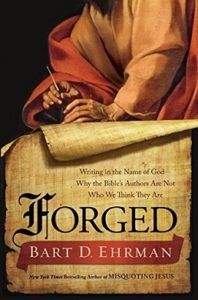 Regarding the way I rearranged Deschner’s books, as can be seen in the index above, he published his Vol. 3, Die Alte Kirche (full title: The Ancient Church: forgery, brain-washing, exploitation, annihilation) in 1990, from which I took the passages of the first couple of chapters of our abridged Vol I. Twenty years later, biblical scholar Bart D. Ehrman published Forged: Writing in the Name of God: Why the Bible’s Authors Are Not Who We Think They Are, pictured left.
Regarding the way I rearranged Deschner’s books, as can be seen in the index above, he published his Vol. 3, Die Alte Kirche (full title: The Ancient Church: forgery, brain-washing, exploitation, annihilation) in 1990, from which I took the passages of the first couple of chapters of our abridged Vol I. Twenty years later, biblical scholar Bart D. Ehrman published Forged: Writing in the Name of God: Why the Bible’s Authors Are Not Who We Think They Are, pictured left.
Yesterday The Occidental Observer published an article in which the author says that the results of the recent midterm elections are due to the fact that Americans are still in a comfort zone, and that they won’t change their paradigm until the dollar collapses (just as the Germans of the degenerate Weimar period didn’t change until their mark hyperinflated).
However, there is a phrase of the author with which I disagree: ‘I don’t want to see anyone suffer.’
Only suffering saves! For example, only the enormous suffering, inflicted by my father’s Catholic beliefs, led me to apostatise from Christianity. If my teenage life hadn’t been completely shattered, as my foreword to the forthcoming edition of Deschner’s book begins, I wouldn’t now have such a negative image of our parents’ religion.
So I hope that the times ahead with the collapse of the dollar will drag the desperate to awaken. (It is time to think about buying silver coins: the recent FTX disaster is deeper than you think: huge losses are coming for all cryptocurrencies).
Changing the subject, the backbone of this site is its books, which after the printer that published them for me refused to reprint them, are now only available as PDFs. Before I post a link to the PDF of the enlarged edition of Christianity’s Criminal History which incorporates blog posts 101-172 of that series, I will do a review reading.
That means that I will not add new entries here until I finish reading all 441 pages of the book. However, visitors can entertain themselves in the meantime. As our friend Ørdnung said yesterday on Twitter, ‘[C.T.] just released an excellent compendium of exterminationist thought. Read it here [link].’
Please note that, as I have no printing press at the moment, I am not earning a single penny from these books which I am offering free to visitors to The West’s Darkest Hour. A donation, however modest, is always appreciated. Although I still maintain my Bitcoin and Monero accounts, my PayPal account is still working.
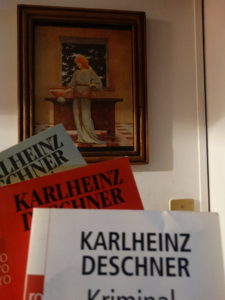 EDITOR’S FOREWORD
EDITOR’S FOREWORD
[pages 5-8 of the forthcoming Edition]
In his after-dinner conversations Hitler said: ‘Christianity is the greatest regression humanity has ever experienced: The Jew has thrown back humanity one and a half thousand years’. And the Romanian philosopher Emil Cioran, who once described himself as a Hitlerist, wrote: ‘The whole world has forgiven Christianity.’
Well, not the whole world. As I confess in my philosophical autobiography De Jesús a Hitler, Christianity played a central role in the destruction of my teenage life and my twenties, something I will never forgive…
Some clarifications
Aleksandr Solzhenitsyn, who was a Christian, wisely allowed Edward Ericson to abbreviate The Gulag Archipelago so that the heavy volumes of the original work could reach a wider audience in a single, readable tome. The present book, Christianity’s Criminal History: Volume I is an abridged translation of the first volumes of Karlheinz Deschner’s Kriminalgeschichte des Christentums. The original German volumes, and also the Spanish translation I have used, contain thousands of endnotes, which are omitted here. This preliminary translation is only the first step towards a more formal German-English translation of Deschner’s maximum opus.
In this abridged translation I have added a few headings, as well as several illustrations with footnotes explaining them, and brackets translating German or Latin terms. Unlike Ericson’s abridgement of the Archipelago, sometimes I have omitted ellipses between unquoted paragraphs, and I have simplified some sentences. I have also replaced some words. I refer to the phrases where the author uses the word ‘pagan’. I replaced it with terms such as ‘Hellenes,’ ‘defenders of Greco-Roman culture,’ ‘classical culture’ or simply added inverted commas on the word ‘pagan.’
The term I have chosen, Hellenes, requires some clarification. It could not be more significant that before the introduction of the pejorative term pagan to refer to unconverted citizens of the Roman Empire, whites were called héllenes or éthne by 4th-century treatises (the expression hellénon éthne can be translated into modern English as ‘the Greek races,’ i.e. the white peoples). As I am aware of the rhetorical use of language, instead of the author’s pejorative term ‘pagan’ I have sometimes chosen the non-pejorative term common in the 4th century vernacular, ‘Hellenes.’
White nationalists claim to be quite informed on the Jewish question. But very few are aware that Jewish subversion began with Christianity, as Hitler said in the opening lines of this preface. Who among today’s nationalists knows the true history of the religion of their parents? Who is aware that Christian fanatics used violence to destroy the ‘pagan’ (i.e., the Greco-Roman world)? Yes: Deschner wrote in German. But how many English-speaking racialists are familiar with Catherine Nixey’s The Darkening Age: The Christian Destruction of the Classical World, published in 2017?
Independently of the nationalists and the racial right, virtually all Westerners ignore the apocalyptic catastrophe of early Christianity after Constantine handed over the Roman Empire to his bishops. They know only the myths of the martyrs (see the chapter ‘The Persecution of the Christians’ in this book), the pious legends, hagiographies and the New Testament fictional tales we were told as children: topics covered in the first section of this abridged translation.
Karlheinz Deschner (1924-2014) was a liberal German. He spent the first sixty years of his life researching the history of the Catholic Church before beginning the ten volumes of his Kriminalgeschichte series in 1986, which he completed in 2013. The series is an encyclopaedic treatise on the true history of Christianity.
I started reading Deschner at the beginning of this century, when I was a liberal, and I would not wake up to the Jewish question until 2010. But Deschner, like all Germans of our time who aspire to see his books in bookshops, never woke up. In his Kriminalgeschichte he went so far as to harshly criticise the anti-Semites of the Early Church: passages omitted in this abridgement. This said, the difference between Deschner and liberal theologians like Hans Küng (The Church) and conservative historians like Paul Johnson (A History of Christianity) is that Küng and Johnson concealed a great deal of the criminal history of Christianity. It is remarkable how Deschner, a scholar who like me became an apostate, was able to see Church history in a way that Küng, Johnson and a veritable galaxy of other Christian scholars would never dream of. After waking up to the reality of the Christian problem I realised that Deschner’s massive work, despite his liberal bias, could be rescued. It just has to be processed through the prism of someone who is racially awake. Of course: if Germany had won the war, Deschner, shown here in National Socialist uniform as a young man, could have written his story from our point of view.
More than one holocaust with millions of victims each has been perpetrated against the Germanic peoples. After 1945, the Allies killed millions of defenceless Germans (see, for example, Thomas Goodrich’s Hellstorm: The Death of Nazi Germany: 1944-1947). This is the best-kept secret of modern history. Conversely, the genocide committed in Germany during the Thirty Years’ War by fanatic Catholics is fairly well known (in the next volume of our abridgement we will incorporate those chapters). But who knows about the millions of other Germanic peoples killed by Emperor Justinian, recounted in this volume?
If the Aryan Man is currently committing ethnosuicide, it is because the System has lied to him about his own History.[1] The System’s favourite method is what we might call lying by omission: not saying, for example, a word about what happened to the Germans in 1945-1947, or how Christianity was imposed on the white race by Constantine and his successors. It was not enough for the Imperial Church to destroy the Greco-Roman world in the 4th and 5th centuries. In the 6th century, after the fall of Rome, Justinian, the Emperor of Constantinople went on to commit a gigantic genocide of the Germanic race, which by then had established itself on the Italian peninsula. Deschner’s chapter on this Holocaust appears in his second volume, Die Spätantike (Late Antiquity), published in 1989. The full title in translation is: ‘Late Antiquity. From the Catholic “child emperors” to the extermination of the Arian Vandals and Ostrogoths under Justinian I (527-565).’ These were the two Germanic peoples that were exterminated during the Byzantine Empire’s military incursion into Italy and Africa (no wonder there are few pure Germanic peoples in those regions today).
Finally, Deschner died in the same year that Richard Carrier published a book which will be considered the most important book since Hermann Samuel Reimarus’ critical approach to the Gospels. I refer to Carrier’s On the Historicity of Jesus: Why We Might Have Reason for Doubt. Deschner did not have the opportunity to evaluate the Christ myth theory in its phase of full exegetical maturity. For a new history of Christianity to be complete, Deschner’s criminal history must be complemented by Carrier’s ongoing work, and even our axiological critique of Christianity (see our booklist on page 3).
César Tort
November 2022
____________
[1] See ‘Foundation Myth’ on pages 90-93 of On Exterminationism.
Thanks to the programme DeepL Translator, which allows me to correct the style (as English is not my mother tongue), I have finished proofreading the November 2022 edition of the book On Exterminationism, which can now be read here.
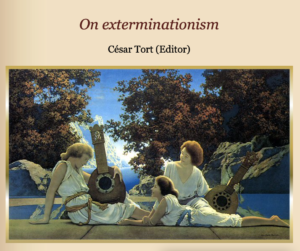 If I receive enough funds, I will hire a cover designer to make this horizontal image appear vertically so that the printed book can be sold through IngramSpark.
If I receive enough funds, I will hire a cover designer to make this horizontal image appear vertically so that the printed book can be sold through IngramSpark.
I would suggest that visitors read the Preface because, compared to the earlier editions, in this one I not only added new articles but removed a large number of articles from the previous edition.
The final three articles, where in addition to my voice the voices of Gaedhal, Maurice and Krist Krusher also appear, provide a good insight into the axiological and metaphysical POV of The West’s Darkest Hour.
I will now add this book to the list of our books in the featured post…
